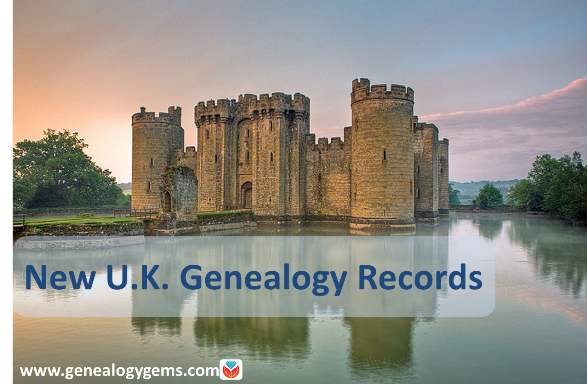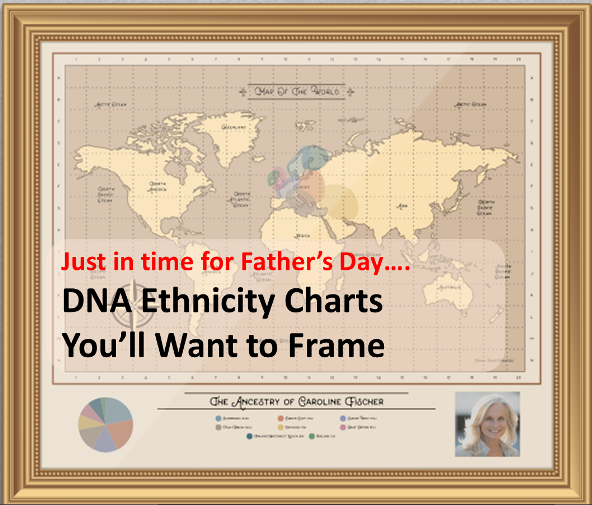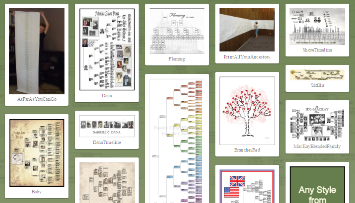Blog


New UK Genealogy Records Online: 1939 Register Updates and More
Got ancestors from England, Scotland, Wales or Northern Island? Check out these new UK genealogy records online: 1939 Register updates; newspapers; Scottish postal directories and local resources for Derbyshire and the city of York.

Featured Update: Additions to the 1939 Register online
 Over 660,000 new records pertaining to empty, uninhabited addresses across England and Wales have been added to Findmypast’s unique and important online 1939 Register resource.
Over 660,000 new records pertaining to empty, uninhabited addresses across England and Wales have been added to Findmypast’s unique and important online 1939 Register resource.
We asked Jim Shaughnessy at Findmypast how these records can help a researcher. “There are a few things that an empty address can tell you,” he responds. “Knowing the house you are looking for was an empty address in 1939 may help you to direct further research. As with other record sets, the occupations of the neighbors can give you an idea of the area (in terms of the largest local employer).”
The ability to search even vacant addresses “can also give you information about areas [later] destroyed by aerial bombing during the War (and during the extensive regeneration in the decades following),” writes Jim. “The Register was compiled September 1939; bombing began in 1940 and a lot of houses wouldn’t have been rebuilt, particularly in impoverished areas where we had bombsites for years and years afterwards. So from that you could look at how the War changed that area or that street: what doesn’t exist now but did pre-Blitz.”
Jim also pointed out that “Findmypast is the only site on which you can search by address on the 1911 census as well as the 1939 register, plus we have the largest collection of electoral rolls, also searchable by address. You can search by address and then build the entire picture of what your family did.”
More UK Genealogy Records Now Online
U.K. Newspapers
The British Newspaper Archive recently added four new titles: the Willesden Chronicle, published in London and the Warrington Guardian, published in Cheshire; the Dudley Herald [Dudley, West Midlands, England] and the Monitor, and Missionary Chronicle, of the Reformed Presbyterian Church in Ireland [Belfast, Northern Ireland]. The British Newspaper Archive now holds over 19.5 million pages of historic newspapers dating from the early 1700s to the early 2000s!
In addition, Findmypast has added over 186,000 records to its collection, Sussex, Eastbourne Gazette Newspaper Notices. “This indexed collection includes names found in the paper’s family notices section (announcements of births, marriages, and deaths) as well as other reports on events such as divorces, murders, tragedies, shipwrecks, lynchings, and paternity cases. The newspaper reported on stories in Sussex, but also internationally.”
Derbyshire, England. Over 800 records have been added to Findmypast’s unique collection of Derbyshire Hospital Admissions and Deaths 1855-1913. “The collection now contains over 5,000 records taken from two different sources: Derbyshire Royal Infirmary, Deaths 1892 – 1912 and Victoria Memorial Cottage Hospital, Ashbourne Admissions 1899 – 1913,” states an announcement. “Each record includes a transcript produced by the Ancestral Archives of Derbyshire. Records can include the patient’s admission date, reason for admission, condition after admission, marital status, residence, rank or profession, date of discharge or death, and cause of death.” Looking for other Derbyshire ancestors? Click here to read about online Methodist records for Derbyshire.
York, England. A new Findmypast resource, The York Collection, includes nearly 300,000 genealogical records documenting over 600 years of residents of the city of York. A press release calls it “the largest online repository of historic City of York records in the world….Fully searchable transcripts of each original document are also included, enabling anyone to go online and search for their York ancestors by name, location, and date.”
The collection is comprised of a variety of fascinating documents, including hearth & window tax records (1665-1778); lists of apprentices and freemen (1272-1930); city of York trade directories; electoral registers (1832-1932), city of York school admission registers; city of York deeds registers (1718-1866); city of York militia & muster rolls (1509-1829), and city of York calendars of prisoners (1739-1851). This collection was published in partnership with Explore York.
Scotland Directories

A snippet from an 1820s post office directory for Aberdeen and vicinity. Image on Findmypast.com.
Over 180,000 new record images have been added to Findmypast.com’s collection of Scottish post office directories, now spanning 1774-1942. The collection has nearly 900 browse-only volumes of directories that offer descriptions of Scottish towns along with lists of residents by occupation and address.
Here’s a little background from Findmypast: “Post directories are an excellent source for family historians wanting to trace ancestors on a yearly basis. Directories allow you to fill in the gaps between the census records. They can also provide vital information about your ancestor’s residence, which can lead to the discovery of more records….Directories can add historical context to your ancestor’s story. Directories will give you a better understanding of where your ancestor lived, such as how many businesses were in the town, how many schools, what day was the market day, and how big was the town.”
“Directories may focus on a particular town or district or you can find national postal directories. The majority of post directories comprise a description of the place, along with lists of people by occupation. For example, you will find lists of magistrates, councillors, sheriffs, police officers, and merchants. It is important to remember that post directories are not complete lists of all the residents in the town or county. Also, many directories fail to include women.”
TIP: A browse-only collection of digitized Scottish post office directories for 1773-1991 is available to search for free online at the National Library of Scotland.
Start researching your English ancestors with this free two-part article series:
 British Research for Beginners (“English” v. “British” and more)
British Research for Beginners (“English” v. “British” and more)
English Parish Records: Finding English Ancestors Before 1837

New DNA Ethnicity Chart: Display Your Heritage
Just in time for Father’s Day! This new DNA ethnicity chart design is a classy and cutting-edge way to share your family history. As wall displays, this is the perfect conversation-starter for your home or heritage gift for a loved one.

There’s a gorgeous new way to display your genetic genealogy from Family ChartMasters! It’s a new custom DNA ethnicity chart, and it’s a fantastic way to spark conversation about your family history with friends and loved ones.
“At Family ChartMasters we believe that family history can save the world,” says owner Janet Hovorka. “The more people know about their background, the more they are inspired with civility, gratitude and compassion for other people because they find out we are all more alike than different. We want to help people make that easy to remember every day.”
Your ethnic “pie chart”
 DNA ethnicity results–those “pie charts” that come with your genetic genealogy test results–are one of the most popular aspects of testing. Even those without an active interest in researching their roots often test just to learn what their DNA says about their genetic roots: How Irish are they? Do they have Jewish roots? Is there any truth to that old family story about being descended from an Indian princess?
DNA ethnicity results–those “pie charts” that come with your genetic genealogy test results–are one of the most popular aspects of testing. Even those without an active interest in researching their roots often test just to learn what their DNA says about their genetic roots: How Irish are they? Do they have Jewish roots? Is there any truth to that old family story about being descended from an Indian princess?
The science behind DNA ethnicity percentages is still being refined, as is evident from the varying ethnicity results you may receive from different companies. But it’s still fascinating to learn–and super shareable with just about anyone!
DNA ethnicity chart options
Family ChartMaster’s new DNA ethnicity chart comes in three themes to fit a variety of different décor styles: Basic, Antique, and Modern. The Basic theme is clean and fresh, and complements most decorating styles. The Antique theme’s sepia-tone finish brings together the styling of antique maps with your high-tech DNA profile. The Modern theme is graphic and bold, with neutral tones well-suited to contemporary décor.

In less than five minutes, you can upload an optional photo and then manually enter your ethnicity estimates from a DNA test. The categories are currently aligned with AncestryDNA’s ethnic regions–which is running a great sale for Father’s Day, by the way, if you’ve been waiting to purchase a test. (Other DNA test providers also have some great prices now; click here to see them.)
After viewing a preview of your DNA ethnicity chart, you can place an order that can be printed on archival Professional Paper or Artist’s Grade Canvas. Following Family ChartMasters’ proven track record of superior service, the beautiful print will arrive rolled in a tube and ready to frame. You can also order PDF downloads for immediate delivery to an email inbox. Pricing starts at $19.95.
(Will your chart come in time for Father’s Day? According to the Family ChartMasters website, orders take 24-48 hours to prepare, and regular shipping takes 2-3 days within the U.S. Faster shipping options are available for an additional charge. If in doubt, order the PDF download.)
These DNA ethnicity charts are perhaps the easiest heritage display you’ll ever make! They also take advantage of the current widespread interest in DNA, making a conversation about your heritage more meaningful and appealing even with those who have never expressed interest in your heritage. Click here to see how to order your DNA ethnicity chart.
 More than DNA charts: Family ChartMasters is an award-winning genealogy chart printing and design service. It is also the official printing service for most worldwide genealogy software, database, and research companies. Family ChartMasters prints any style of family history chart from any kind of file. They offer oversized draft-quality family reunion charts as well as custom decorative designs.
More than DNA charts: Family ChartMasters is an award-winning genealogy chart printing and design service. It is also the official printing service for most worldwide genealogy software, database, and research companies. Family ChartMasters prints any style of family history chart from any kind of file. They offer oversized draft-quality family reunion charts as well as custom decorative designs.
 Click below to read more about….
Click below to read more about….

Learn about Homestead Land Records with Lisa Louise Cooke
Homestead land records tell us more about our forebears who settled the western U.S. Learn more with Lisa Louise Cooke at the Land Records and Genealogy Symposium July 14-15, 2017 in Beatrice, Nebraska.

Lisa Louise Cooke will be a featured speaker at the Land Records and Genealogy Symposium in Beatrice, Nebraska on July 14-15, 2017. The 2-day event is co-sponsored by the Homestead National Monument of America, a unit of the National Park Service, and the Beatrice Campus of Southeast Community College.
Homestead land records and our ancestors

Omer Madison Kem, (later, Representative to the United States Congress) in front of his sod house in Nebraska (1886). Click image to view at American Memory (Library of Congress digital archive).
“The Homestead Act of 1862 had a profound affect on the United States and throughout the world,” states the symposium webpage. “Under the provisions of this law, the U.S. government gave away 270 million acres of land to 1.6 million individuals and families for the purposes of settlement and cultivation. Today there may be as many as 93 million descendants of homesteaders.”
Our homesteading ancestors may show up in land patent records and related paperwork. Over five million documents are searchable by name and location at the Bureau of Land Management’s General Land Office Records website. These databases found at major genealogy websites may also be helpful for finding homestead land records and related paperwork:
- Free at FamilySearch.org: United States, Cancelled, Relinquished, or Rejected Land Entry Case Files, 1861-1932;
- By subscription at Ancestry.com: U.S., Homestead Records, 1861-1908;
- By subscription at Fold3.com: Homestead Records NE
Out ancestors’ homestead land records may reveal when they purchased and/or applied for land and where they were living at the time. In many instances, immigrants had to be citizens to purchase land, so you may find information about their naturalization. You’ll often find land records in the same area purchased by relatives, which can help you reconstruct family groups and more confidently identify your family.
Participants in the Land Records and Genealogy Symposium will learn to use records of different kinds–and strategies for researching them–in their genealogical and historical research. Lisa Louise Cooke’s lectures will focus on using powerful online tools to map out your family history and find mention of ancestors that may be buried deep in online resources. Other lectures will also help you chart the stories of your frontier ancestors, many of them immigrants, who purchased land from the government in the Midwest and Western United States.
What: Land Records and Genealogy Symposium, co-sponsored by the Homestead National Monument of America (National Park Service) and the Beatrice Campus of Southeast Community College
When: July 14-15, 2017 (8 am – 4 pm on Friday, with optional dinner presentation; 8:30 am – 3 pm on Saturday)
Where: Southeast Community College, Beatrice, Nebraska
Can’t make it to Nebraska?
 Learn to plot your ancestors’ homestead records in Google Earth in Lisa Louise Cooke’s Google Earth for Genealogy video series.
Learn to plot your ancestors’ homestead records in Google Earth in Lisa Louise Cooke’s Google Earth for Genealogy video series.
Genealogy Gems Premium website members can learn more about homestead land records in Genealogy Gems Premium Podcast episode 33, in an interview with expert Billie Edgington. (Click here to learn more about all the benefits of Premium membership, including access to the full Premium Podcast archive of nearly 150 episodes!)
Click here to see all of Lisa’s upcoming presentations: is there one near you?




